There are easy steps to maintain your car’s engine. First, consider the most common causes of engine problems:
- Lack of regular oil changes
- Driving low on oil
- Overheating
- Using low quality fuel or oil
- Racing, driving only short trips, excessive idling
- Design and parts flaws
Why regular oil changes are important?
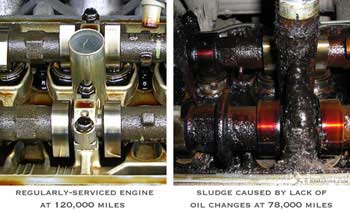
Oil sludge.
|
Your engine has a lot of moving and rotating parts and needs to be well lubricated. That’s the function of the engine oil. As you drive, engine oil gradually degrades. It loses its lubricating qualities and carbonizes under high temperatures. If you continue driving much longer past the regular oil interval, the friction slowly increases causing mechanical wear and the engine slowly gets contaminated with carbon deposits or sludge (in the photo). Through the engine ventilation system these carbon deposits are transferred into the engine intake and build up inside the throttle body and on the valves. This might cause lack of power, rough idle, Check Engine light and various driveability issues. If you don’t remember when you have done your last oil change, check the engine oil with the dipstick; if it looks too dirty, have the oil change done.
Why do you need to check your oil level?
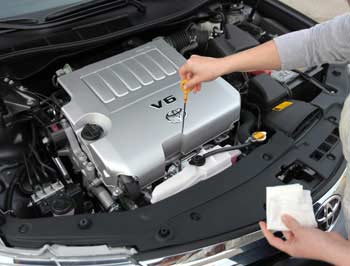
Check engine oil level
|
Over time, the engine oil level drops because some amount of oil gets burned in the engine. Car manufacturers recommend checking oil level at every fill-up. With our busy lives, this doesn’t sound realistic, but if you at least check it once a month, you might be able to catch your oil level getting low and top it up or have the oil change done. It takes just a couple minutes to check the oil level; all you need is a level spot to park you car and a clean rag to wipe out your dipstick.
Protecting your engine from overheating
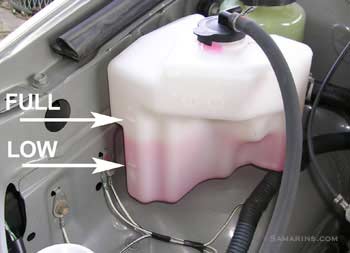
Keep the engine coolant level full
|
A problem with a cooling system can cause the engine to overheat, and this can result in serious damage to the engine. One of the common problems with a cooling system is lack of coolant caused by leaks. Coolant leaks are very common in many cars. If you found a coolant leak in the engine compartment or on your parking spot, have it fixed before lack of coolant will cause overheating; coolant is usually green, orange or red in color. If you notice the engine temperature rising above normal, have your car checked out before the engine overheats.
Synthetic oil versus conventional mineral oil
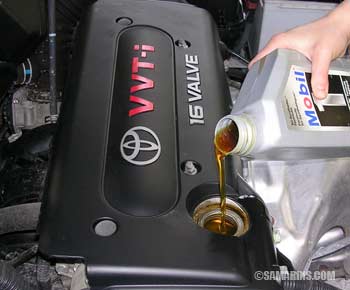
Synthetic oil
|
Many newer cars require synthetic oil, as it offers better protection for the engine. The advantage of synthetic oil is that it can withstand higher temperature and can work longer without losing its lubricating qualities. Synthetic oil doesn’t get thicker at below-zero temperatures and provides better engine lubrication at a cold start. Using synthetic oil makes perfect sense if you have a low-mileage or turbo engine or often drive under severe conditions such as high temperatures, excessive load or long intervals without an oil change.
However, using synthetic oil in high-mileage engines is not always worth the extra cost. Since synthetic oil is “thinner,” a high-mileage engine filled with synthetic oil is more likely to develop leaks or run noisier.
When your timing belt or chain needs to be changed
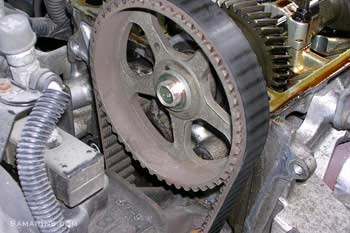
Timing belt
|
A timing belt synchronizes the crankshaft with the camshaft, so that valves operated by the camshaft open and close in sync with piston movement. A timing belt should be replaced at recommended by the manufacturer intervals; usually from 60,000 miles to 105,000 miles (96,000-168,000 km). A timing belt may also need to be replaced if it shows signs of wear or is soaked in engine oil. If the timing belt breaks, your car won’t be driveable. In some cars, if the timing belt breaks while the engine is running, the engine could be severely damaged. If you don’t know when the timing belt was replaced last time, ask your mechanic to check its condition; usually it’s easy to check if the timing belt is in good or bad shape.
Getting a regular tune-up
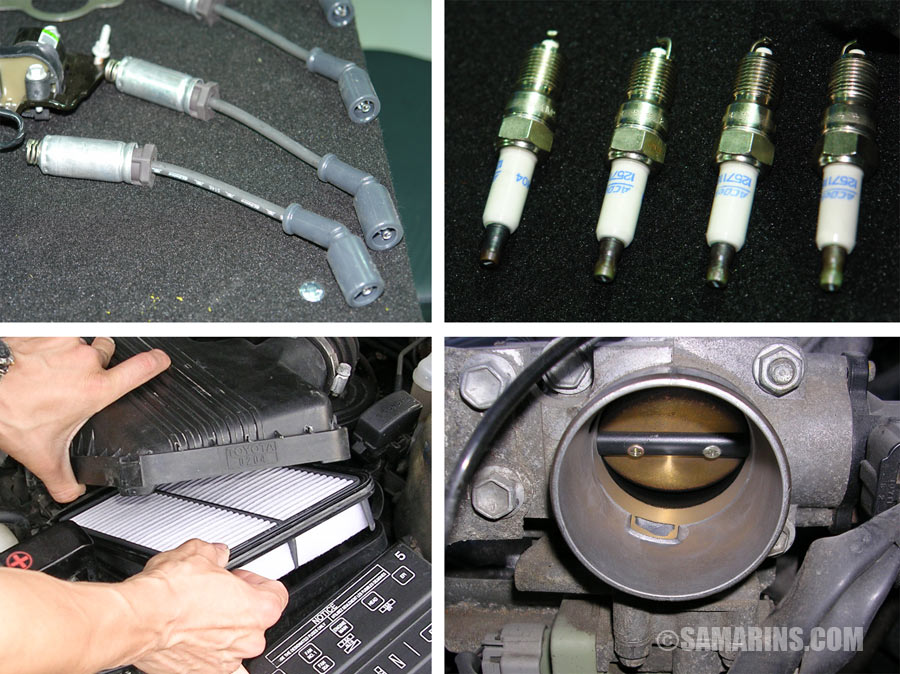 |
If your engine feels sluggish, lacks power, misfires or runs rough, a good tune-up often can make a notable difference. A tune-up is typically done every 60,000-90,000 miles. In newer cars, a tune-up may include changing the spark plugs, air filter and possible cleaning the throttle body. In older cars, distributor cap and rotor, ignition wires and fuel filter may also need to be replaced. Often, your mechanic may suggest cleaning the engine throttle body, as when it’s dirty, it can cause rough idle and the Check Engine light coming on. A PCV valve may also need cleaning or replacing. A fuel injection cleaning service is another often suggested tune-up item, where a special cleaning solution is run through the fuel injectors while the engine is running. In a high-mileage engine, cleaning the fuel injectors may help improve gas mileage and restore some of the engine power.
Change your air filter in recommended intervals
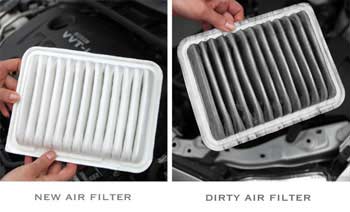 |
An engine air filter prevents dust and other debre from entering into your engine. A dirty air filter can restricts air supply to your engine, causing sluggishness and lack of power. An old air filter can acually collapse or rip through, allowing unfiltered air, dust and other debree into the engine, causing it to wear faster. An air filter is typically replaced every 15,000-20,000 miles or more often if you regularly drive on unpaved or dusty roads.
Change worn engine drive belt(s)
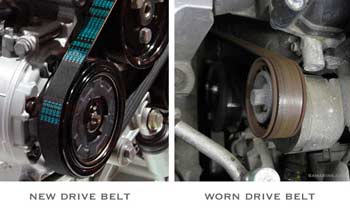 |
A drive belt runs an alternator, air-conditioner compressor and other accessories attached to your engine. Some cars have only one drive belt, others may have two or three belts. Over time, a drive belt wears out; squeaking is the first early sign that a drive belt needs to be checked. An extremely worn or cracked drive belt may break disabling your engine. Typically, a drive belt is inspected during an oil change service. If a drive belt shows signs of wear or cracks, it needs to be replaced.








